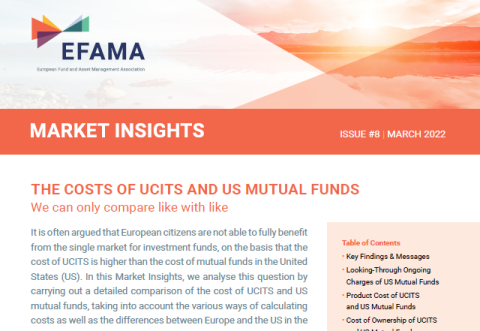EU Fund regulation
The EU fund product landscape is deep, diverse and dynamic. Since the birth of the UCITS framework in 1985, European institutions have progressively refined it into a global “gold standard”, one that successfully balances strict regulatory requirements with the flexibility required by manager to meet evolving client demands. The successful evolution of UCITS was followed by the creation of alternative investment funds (AIFs) under the 2011 AIFM Directive, adding a second important pillar to EU fund/manager regulation. Building on this second pillar are further ambitious EU fund products, such as EUSEFs, EUVECAs and ELTIFs. EFAMA has helped guide all of these key regulatory developments, informing policymakers and regulators on their main merits and drawbacks, while also keeping a close eye on their respective review initiatives.
EFAMA strongly supports a fundamental review to the ELTIF regime, in view of broadening its eligible investment universe and adapting it to better meet retail investor needs. We are also closely monitoring the review of the AIFM Directive from a product regulation standpoint, including possible spillover effects on the UCITS Directive requirements. Further work involves keeping pace with relevant ESMA initiatives, such as the work around the Common Supervisory Action on costs and fees for UCITS.
EFAMA's response to ESMA's CP on Implementing technical Standards under Regulation (EU) 2019/1156
Counterparty and liquidity risks in ETFs - EFAMA response to ECB
Our comment paper confutes the ECB study’s main findings by focusing on its two core areas, namely
liquidity and counterparty risks inherent to the structure and functioning of ETFs. A final section
considers the merits of further regulatory action addressed at the European ETF industry.
EFAMA’s comments on ESMA’s CP on Draft regulatory technical standards under Article 25 of ELTIF Regulation
High-level response to ESMA consultation on notifications for cross-border marketing and management of AIFs and UCITS
EFAMA welcomes the European Securities and Market Authority’s continuous commitment to creating a single market for investment funds, confirmed by the draft regulatory standards currently under consideration. These RTS/ITS would further harmonise information that asset managers should provide to their national competent authorities before marketing or managing an investment fund on a cross-border basis, thus facilitating intra-EU product distribution.
EFAMA reply to EC targeted consultation on the functioning of the Money Market Fund Regulation
The European Fund and Asset Management Association (EFAMA) has published its response to the European Commission’s targeted consultation on the functioning of the EU Money Market Fund Regulation (MMFR).
US mutual funds are not necessarily cheaper than UCITS | EFAMA Market Insights Issue #8
EFAMA released today issue number eight of its Market Insights series titled 'The Costs of UCITS and US Mutual Funds - We can only compare like with like'. This
3 Questions to Keshava Shastry on "Demystifying ETPs: a simple guide for the European investor"
Q #1 Why did EFAMA members feel the need to publish this ETP investor guide?
Asset Management in Europe - An Overview of the Asset Management Industry - November 2020
The report aims to provide a unique and comprehensive set of facts and figures on the state of the industry at the end of 2018 but also to highlight the fundamental role of asset managers in the financial system and wider economy.
European MMFs in the Covid-19 market turmoil: Evidence, experience and tentative considerations around eventual future reforms
The pandemic-induced market events experienced in March 2020 have marked the first true ‘stress-test’ for European MMFs, following the introduction of the EU Money Market Fund Regulation (MMFR) in 2017. Despite the severity of the liquidity stress in the secondary market for short-term instruments and the significant outflows experienced by European MMFs across all three of the MMFR-identified categories (public debt CNAV, LVNAV and VNAV), funds proved resilient.


































